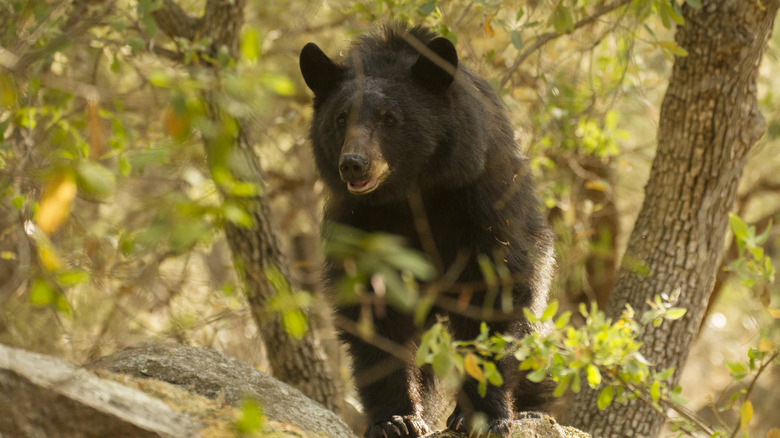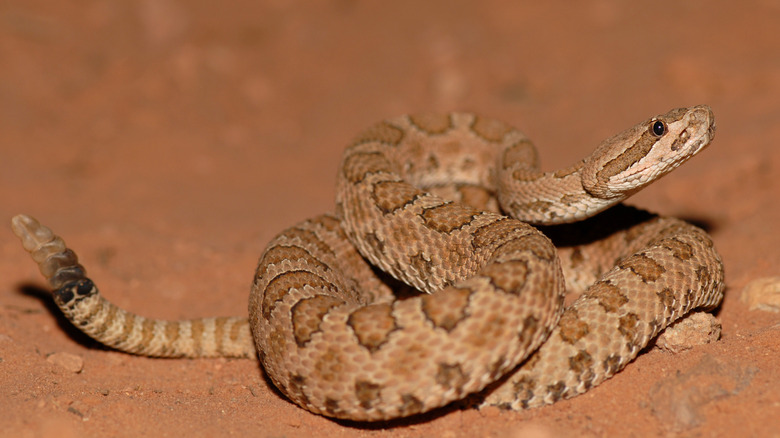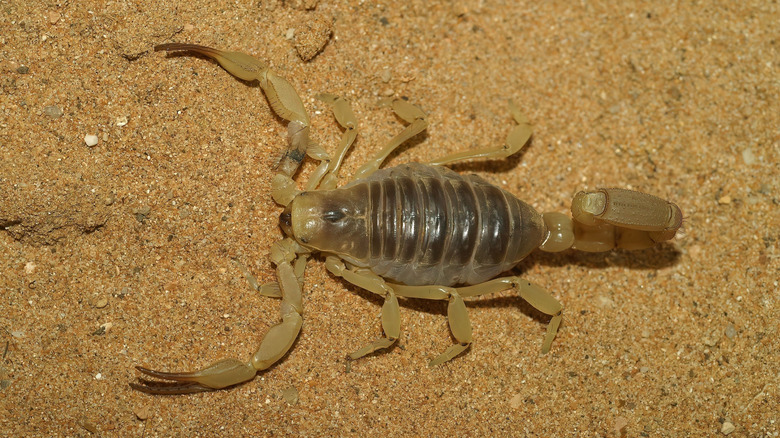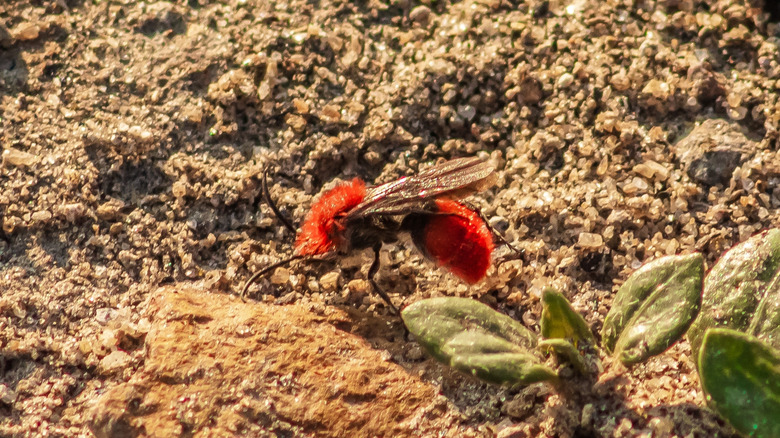Creatures To Look Out For When Visiting Arches National Park
We may receive a commission on purchases made from links.
With thousands of stone arches that have formed naturally over millennia as well as countless other stunning geographic features, Arches National Park in Utah should be on everyone's national park bucket list. Not only is this 114 square mile park home to the world's largest concentration of such structures, it is also the place of residence for a myriad of wild creatures. While the vast majority of these insects, reptiles, amphibians, arachnids, birds, and mammals are harmless, some do pose potential problems for those adventuring within Arches National Park.
Just as the weather conditions within Arches National Park can range from extreme, dry heat to bitter, snowy cold, the risky critters run the spectrum from tiny stinging insects to massive mammals. As a result, those spending time in Arches should not only be equipped with a well-stocked emergency supply bag, they should also always pack bear spray, like a canister of SABRE Frontiersman. This way, they are prepared from anything that may arise, from a hiking accident to a hostile animal encounter. After all, from big to small, there are several creatures to look out for when visiting Arches National Park.
Black bears are found in Arches National Park
It may come as a surprise to many, but black bears are regularly found throughout the state of Utah, including within Arches National Park. These bears typically meander their way through the park in either late August or September, as they move down from the nearby La Sal Mountains. As of now, these are the only bears you need to be concerned with in this area. However, soon there may be another type of dangerous bear to look out for, as there is a possibility that grizzly bears will be seen in Utah again at some point in the future. Grizzlies are currently found in neighboring states and continue to expand their range.
Even though black bears are the lone species to roam Utah at the moment, it is important to carry bear spray and know how to use it. Additionally, it is a good idea to make noise to avoid bears when hiking or adventuring in Arches National Park. However, having only black bears within the park simplifies the process of knowing what to do if you encounter or are attacked by a bear. Although black bears are typically scared away more easily than grizzlies, they can and do attack. Your response, however, is different if charged by a black bear. Instead of playing dead, as is recommended during a grizzly encounter, you should fight back against an attacking black bear.
Mountain lions are elusive but dangerous
Although they are capable of growing to nearly eight feet long and weigh as much as 200 pounds, mountain lions are very elusive and are not often seen, even in areas that have a very high population of these large cats. However, even though you may not see or hear them, mountain lions are active year-round and can present a danger to those adventuring in Arches National Park. As a result, it's crucial to know what to do if you ever come across a mountain lion.
The best way to stay safe when exploring areas mountain lions are known to roam is to avoid adventuring alone, keep children close, and pets leashed. Additionally, you should be aware of your surroundings and alertly looking for signs a mountain lion may be nearby. These include things like scat, claw marks on rocks or trees, and even freshly killed carcasses of other animals. It is also helpful to make noise as you move along the trail, as these big cats are likely to slink away if they know humans are approaching.
If you do encounter a mountain lion, you should never try to move closer to the lion, nor should you run from it. It is also important not to crouch down or bend over, as this can make you look even more like prey to the lion. Instead, attempt to make yourself look as large as possible, maintain eye contact, slowly wave your arms overhead, and speak in a firm voice. If the cat does attack, fight back, even using bear spray if you have it.
Midget faded rattlesnakes represent a real danger
The midget faded rattlesnake is the only dangerous type of snake found in Arches National Park. This snake is not large, ranging from roughly 20 to 30 inches in length. It is also not as widely distributed as other rattlesnakes, being found only in portions of Utah, Colorado, and Wyoming. However, despite its diminutive size and range, the midget faded rattlesnake has a more potent venom than virtually every other type of rattlesnake in North America.
Given the toxicity level of this snake's venom, you should know what to do if you encounter a rattlesnake while hiking or adventuring in Arches National Park. Typically, these snakes spend the majority of their time tucked into rocky crevices, burrows, and holes. So, you should always be aware of where you are reaching or stepping, especially if climbing. At night, midget faded rattlesnakes are more active in open areas, so don't let your guard down after dark.
If you do come across a rattlesnake, give it plenty of room. Do not attempt to approach, handle, or kill the snake. Instead, allow it to move off on its own. Additionally, do not throw anything such as rocks or sticks at the snake in an attempt to scare it away. If the snake does not move away on its own, back away while keeping an eye on the snake or circle around the snake to get back on the trail.
Spiders and scorpions can bite and sting
Although there are several arachnids which call Arches National Park home, visitors only need beware of two: the black widow spider and giant hairy scorpion. These are the only two poisonous arachnids found within the park's boundaries, but they are both capable of inflicting serious harm. In fact, black widows can inflict a dangerous spider bite that requires medical care. The sting of a giant hairy scorpion is not very pleasant, but not nearly as dangerous as a black widow bite. Nonetheless, having the knowledge of what to do if stung by a scorpion or bitten by a spider is essential to remember before adventuring in this area.
The first aid for both a spider bite and scorpion sting follow basically the same steps. You should wash the area, then apply ice if possible. It is also necessary to remove jewelry, loosen tight clothing, and keep the wound elevated. The biggest difference is with a black widow bite, you should seek medical attention immediately, whereas with a scorpion sting it is possible to just monitor for any severe reaction before heading to the E.R. The best way to avoid these bites and stings is to shake out blankets, clothing, shoes, and boots before putting them on and watch where you are placing your hands when reaching for something.
Stinging insects can cause plenty of pain
As is the case when adventuring anywhere outdoors, you can expect to deal with a host of insects in Arches National Park. Among these pests are a number of insects that can cause plenty of pain and discomfort. In addition to mosquitoes, it is not uncommon to encounter bees, wasps, and hornets. The park is also home to velvet ants. Also known as cow killers, these insects are actually not an ant, but rather a type of wasp.
The biggest danger of mosquitoes isn't the stinging itch that comes from their sucking blood from your body, but rather from what they can put into your body in the form of diseases such as malaria, West Nile, zika, and more. In order to help prevent contracting viruses and parasites spread by these pesky pests, you can use a variety of soothing scents and natural oils to repel mosquitoes naturally.
Bees, wasps, hornets, and velvet ants are all capable of delivering painful stings. The severity of these stings can range from pain and slight swelling to full-blown medical emergencies in the case of an allergic reaction. If you are stung, quickly remove the stinger. This is usually best done by scraping the skin with a credit card or something similar. Then, wash the area, apply ice, and, if necessary, take an over-the-counter antihistamine. Monitor for any signs of an allergic reaction, such as severe swelling, rapid heart beat, or difficulty breathing. If these symptoms are observed, seek medical help.





